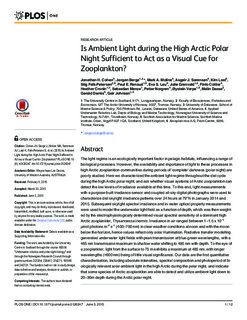| dc.contributor.author | Cohen, Jonathan H. | |
| dc.contributor.author | Berge, Jørgen | |
| dc.contributor.author | Moline, Mark A. | |
| dc.contributor.author | Sørensen, Asgeir Johan | |
| dc.contributor.author | Last, Kim | |
| dc.contributor.author | Falk-Petersen, Stig | |
| dc.contributor.author | Renaud, Paul | |
| dc.contributor.author | Leu, Eva | |
| dc.contributor.author | Grenvald, Julie Cornelius | |
| dc.contributor.author | Cottier, Finlo | |
| dc.contributor.author | Cronin, Heather | |
| dc.contributor.author | Menze, Sebastian | |
| dc.contributor.author | Norgren, Petter | |
| dc.contributor.author | Varpe, Øystein | |
| dc.contributor.author | Daase, Malin | |
| dc.contributor.author | Darnis, Gérald | |
| dc.contributor.author | Johnsen, Geir | |
| dc.date.accessioned | 2015-11-25T11:09:57Z | |
| dc.date.accessioned | 2016-01-05T13:22:14Z | |
| dc.date.available | 2015-11-25T11:09:57Z | |
| dc.date.available | 2016-01-05T13:22:14Z | |
| dc.date.issued | 2015 | |
| dc.identifier.citation | PLoS ONE 2015, 10(6) | nb_NO |
| dc.identifier.issn | 1932-6203 | |
| dc.identifier.uri | http://hdl.handle.net/11250/2372638 | |
| dc.description.abstract | The light regime is an ecologically important factor in pelagic habitats, influencing a range of biological processes. However, the availability and importance of light to these processes in high Arctic zooplankton communities during periods of 'complete' darkness (polar night) are poorly studied. Here we characterized the ambient light regime throughout the diel cycle during the high Arctic polar night, and ask whether visual systems of Arctic zooplankton can detect the low levels of irradiance available at this time. To this end, light measurements with a purpose-built irradiance sensor and coupled all-sky digital photographs were used to characterize diel skylight irradiance patterns over 24 hours at 79°N in January 2014 and 2015. Subsequent skylight spectral irradiance and in-water optical property measurements were used to model the underwater light field as a function of depth, which was then weighted by the electrophysiologically determined visual spectral sensitivity of a dominant high Arctic zooplankter, Thysanoessa inermis. Irradiance in air ranged between 1–1.5 x 10-5 μmol photons m-2 s-1 (400–700 nm) in clear weather conditions at noon and with the moon below the horizon, hence values reflect only solar illumination. Radiative transfer modelling generated underwater light fields with peak transmission at blue-green wavelengths, with a 465 nm transmission maximum in shallow water shifting to 485 nm with depth. To the eye of a zooplankter, light from the surface to 75 m exhibits a maximum at 485 nm, with longer wavelengths (>600 nm) being of little visual significance. Our data are the first quantitative characterisation, including absolute intensities, spectral composition and photoperiod of biologically relevant solar ambient light in the high Arctic during the polar night, and indicate that some species of Arctic zooplankton are able to detect and utilize ambient light down to 20–30m depth during the Arctic polar night. | nb_NO |
| dc.language.iso | eng | nb_NO |
| dc.publisher | Public Library of Science | nb_NO |
| dc.title | Is ambient light during the high Arctic polar night sufficient to act as a visual cue for zooplankton? | nb_NO |
| dc.type | Journal article | nb_NO |
| dc.date.updated | 2015-11-25T11:09:57Z | |
| dc.source.volume | 10 | nb_NO |
| dc.source.journal | PLoS ONE | nb_NO |
| dc.source.issue | 6 | nb_NO |
| dc.identifier.doi | 10.1371/journal.pone.0126247 | |
| dc.identifier.cristin | 1259305 | |
| dc.description.localcode | This is an open access article, free of all copyright, and may be freely reproduced, distributed, transmitted, modified, built upon, or otherwise used by anyone for any lawful purpose. The work is made available under the Creative Commons CC0 public domain dedication. | nb_NO |
